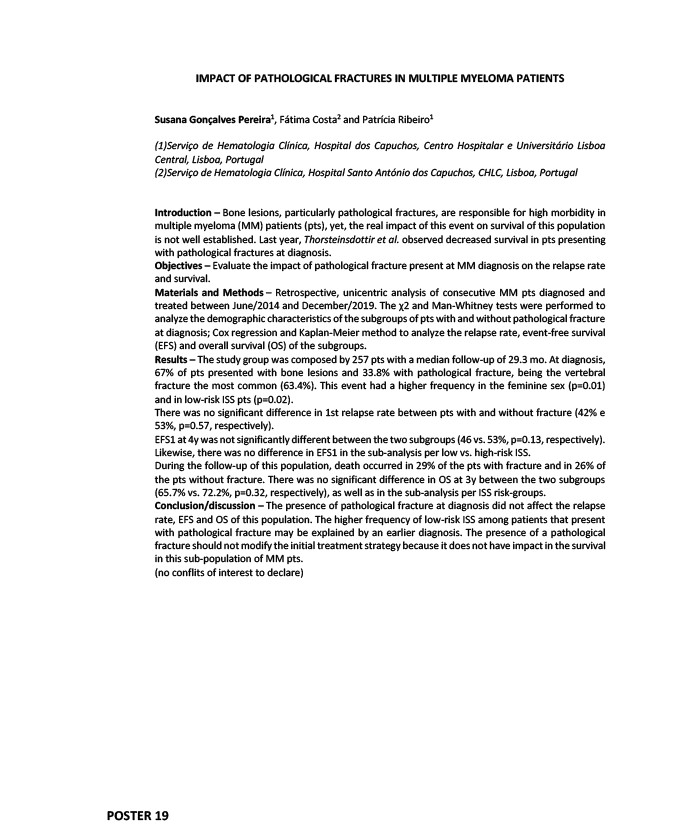
POSTER 19
IMPACT OF PATHOLOGICAL FRACTURES IN MULTIPLE MYELOMA PATIENTS
Susana Gonçalves Pereira1, Fátima Costa2 and Patrícia Ribeiro1
(1)Serviço de Hematologia Clínica, Hospital dos Capuchos, Centro Hospitalar e Universitário Lisboa
Central, Lisboa, Portugal
(2)Serviço de Hematologia Clínica, Hospital Santo António dos Capuchos, CHLC, Lisboa, Portugal
Introduction – Bone lesions, particularly pathological fractures, are responsible for high morbidity in
multiple myeloma (MM) patients (pts), yet, the real impact of this event on survival of this population
is not well established. Last year, Thorsteinsdottir et al. observed decreased survival in pts presenting
with pathological fractures at diagnosis.
Objectives – Evaluate the impact of pathological fracture present at MM diagnosis on the relapse rate
and survival.
Materials and Methods – Retrospective, unicentric analysis of consecutive MM pts diagnosed and
treated between June/2014 and December/2019. The χ2 and Man-Whitney tests were performed to
analyze the demographic characteristics of the subgroups of pts with and without pathological fracture
at diagnosis; Cox regression and Kaplan-Meier method to analyze the relapse rate, event-free survival
(EFS) and overall survival (OS) of the subgroups.
Results – The study group was composed by 257 pts with a median follow-up of 29.3 mo. At diagnosis,
67% of pts presented with bone lesions and 33.8% with pathological fracture, being the vertebral
fracture the most common (63.4%). This event had a higher frequency in the feminine sex (p=0.01)
and in low-risk ISS pts (p=0.02).
There was no significant difference in 1st relapse rate between pts with and without fracture (42% e
53%, p=0.57, respectively).
EFS1 at 4y was not significantly different between the two subgroups (46 vs. 53%, p=0.13, respectively).
Likewise, there was no difference in EFS1 in the sub-analysis per low vs. high-risk ISS.
During the follow-up of this population, death occurred in 29% of the pts with fracture and in 26% of
the pts without fracture. There was no significant difference in OS at 3y between the two subgroups
(65.7% vs. 72.2%, p=0.32, respectively), as well as in the sub-analysis per ISS risk-groups.
Conclusion/discussion – The presence of pathological fracture at diagnosis did not affect the relapse
rate, EFS and OS of this population. The higher frequency of low-risk ISS among patients that present
with pathological fracture may be explained by an earlier diagnosis. The presence of a pathological
fracture should not modify the initial treatment strategy because it does not have impact in the survival
in this sub-population of MM pts.
(no conflits of interest to declare)